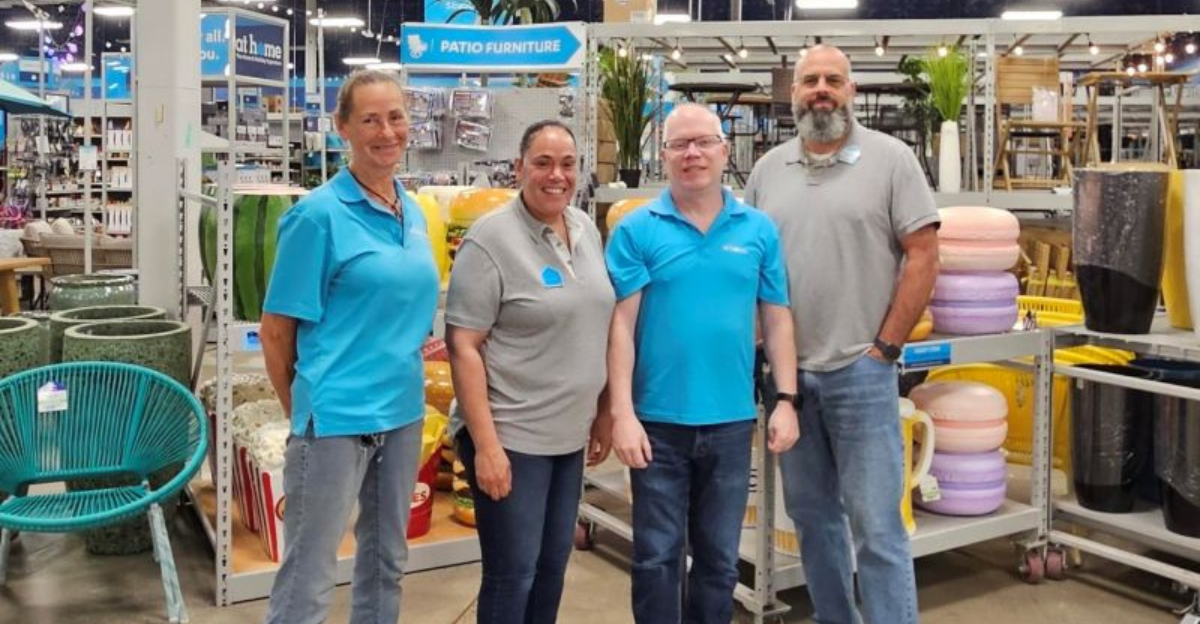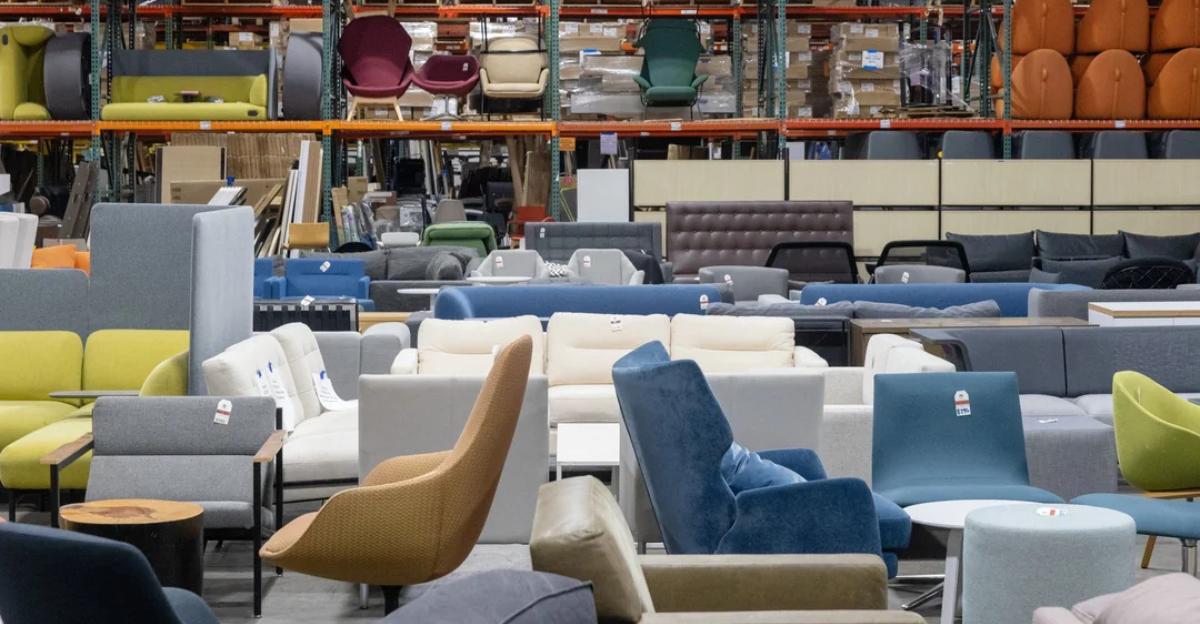
The big-box home décor chain that once promised stylish living rooms on a budget just filed for bankruptcy; and no, this isn’t some minor restructuring.
At Home is in deep trouble. Millennials who’ve spent years nesting and furnishing with every paycheck feel this more personally. Regardless if you’re a DIY wall-art junkie or a discount throw-pillow hoarder, the fall of At Home could make 2025 a much harder year to, well… feel at home.
1. Background: At Home’s Rise and Market Position

At Home wasn’t always on life support; in fact, it was booming not too long ago. The brand carved a niche as the go-to spot for trendy, affordable home goods in warehouse-sized stores. Millennials loved it as there were plenty of options, low prices, and no pushy salespeople. It felt like shopping freedom… until it didn’t.
2. The Shift in Consumer Shopping Habits Affecting Retail

Millennials used to love the weekend store stroll. But maybe not so much now. Convenience wins. Between work, side gigs, and doom-scrolling, shopping happens online, in bed, half-asleep. Retailers like At Home didn’t pivot fast enough. While trends shifted to clicks over carts, At Home kept betting on aisles and forklifts. Their mistake was in not following the trend.
3. Impact of Online Shopping on Brick-and-Mortar Stores

Let’s be honest, it’s just easier to shop in pajamas. With a few taps, your cart is full and your doorstep is busy. Stores like At Home couldn’t keep up with that kind of speed and comfort. While we were clicking, they were stacking shelves. And, well, they couldn’t just keep up.
4. Economic Factors Behind At Home’s Financial Struggles

We can all agree that the economy has not been exactly friendly in recent times. Between interest rate hikes, supply chain chaos, and shifting consumer confidence, At Home got caught in the blender. People spent less on non-essentials: like decorative vases and accent chairs. And when the money dries up, so do the shopping carts.
5. High Mortgage Rates and Depressed Home Buying Activity

When mortgage rates skyrocket, people stop buying homes. And if no one’s moving in, no one’s redecorating. That’s bad news for a store built around furnishing fresh spaces. Millennials already struggling to afford property, (let’s not even get started on Gen Zs!) just weren’t browsing for wall art. They were budgeting for rent and ramen, again.
6. The Role of Tariffs and Trade Environment Volatility

Most of At Home’s inventory wasn’t made down the street; it came from overseas. And when tariffs swung like a wrecking ball, prices climbed before products even hit the shelves. Add in global shipping drama and fluctuating trade deals, and suddenly those “affordable” shelves weren’t so affordable anymore.
6. At Home’s Debt Load and Bankruptcy Restructuring Plan

Debt doesn’t decorate a room… but At Home had plenty of it. The company loaded up on loans during expansion, hoping bigger meant better. It didn’t. Sales slowed, debt piled up, and now bankruptcy is the last-ditch plan. Restructuring sounds clean on paper, but it usually means closures and cuts.
7. Store Closures: What Millennial Shoppers Will Lose Locally

Once those doors shut, they don’t reopen. Whole neighborhoods could lose their go-to spot for budget rugs and impulse buys. No more last-minute decor runs before the in-laws visit. For many millennials, especially in suburbs and smaller cities, that’s one more accessible option wiped off the map.
8. Reduced Access to Affordable Home Goods and Décor

Let’s be real.. bougie aesthetics on a low budget isn’t easy. At Home was one of the few places millennials could score stylish pieces without selling a kidney. Without it, options shrink. And no, overpriced boutiques and sketchy Facebook Marketplace pickups aren’t exactly filling the void.
9. How Bankruptcy Affects Product Availability and Variety

Bankruptcy means suppliers get nervous, and shelves get weird. Expect fewer restocks, oddball inventory, and missing fan favorites. At Home was known for this eclectic variety. Safe to say that’s gone now. Shoppers might walk in for a velvet ottoman and leave with three broken picture frames and a scented candle from 2019.
10. Impact on Prices: Will Costs Rise for Remaining Stores?

Probably. With fewer locations, tighter budgets, and anxious suppliers, prices tend to creep up… even at a “discount” store. Bargain bins might start looking suspiciously full-priced. Millennials hoping for deals could instead find themselves choosing between one overpriced planter or none at all. Not exactly a win for wallets.
12. The Emotional and Experiential Aspect of Shopping at At Home

Scrolling just isn’t the same. At Home offered the joy of wandering, of tossing random things in your cart and pretending you had design taste. It was a vibe, a flex. A therapy session in 100,000 square feet. Losing that space hits different, especially for millennials who made it part of their weekend rituals.
13. Consequences for Millennial Budgeting and Home Furnishing Plans

Millennials already juggle rent, student loans, and groceries like it’s a game show. At Home helped stretch the home décor budget just a little further. Without it, furnishing plans get delayed, or worse, downgraded. That “vision board” bedroom? Might just stay a Pinterest fantasy for a while longer.
14. Comparison with Other Retail Bankruptcies Affecting Millennials

We’ve seen this movie before: remember Bed Bath & Beyond? Or Party City? Each closure chips away at millennial shopping habits. These weren’t just stores, they were part of a routine. At Home joins a growing list of once-loved retailers vanishing, leaving behind empty shelves and nostalgic frustration.
15. The Role of Inflation and Rising Costs on Millennial Spending Power

Groceries cost more. Gas costs more. Even iced coffee feels like a luxury now. Inflation has squeezed every dollar, forcing millennials to cut “non-essentials”; like a surgeon cuts out a cancer. At Home’s prices used to offer relief. But in a world of rising costs, even budget stores start to hurt.
16. Millennial Debt and Bankruptcy Trends in the Broader Economy

It’s not just companies filing bankruptcy, millennials are feeling the pinch too. Credit card debt is climbing, emergency savings are shrinking, and financial anxiety is peaking. At Home’s collapse mirrors a bigger trend, one where both shoppers and sellers are stretched too thin to keep up. The system’s cracking on both ends.
17. How At Home’s Bankruptcy Reflects Larger Retail Industry Challenges

This isn’t just At Home’s problem. Retail is shifting, fast. Legacy chains are struggling to adapt while younger consumers expect faster, cheaper, better, and all online. Bankruptcy filings like this highlight how fragile the old retail model really is. And sadly, stores like At Home can’t keep dodging the cracks forever.
18. Potential Long-Term Effects on Millennial Consumer Behavior

When a store like At Home disappears, it messes with how people shop. Millennials might start second-guessing where they spend, leaning more on online deals, resale apps, or just plain buying less.
19. Conclusion

With At Home out of the picture, millennials face fewer choices, higher prices, and more retail nostalgia. But it’s not all doom. Thrifting, DIY, and digital-native brands might fill the void…sort of. The landscape’s shifting fast, and while the aisles may be gone, the hunt for affordable style marches on.
